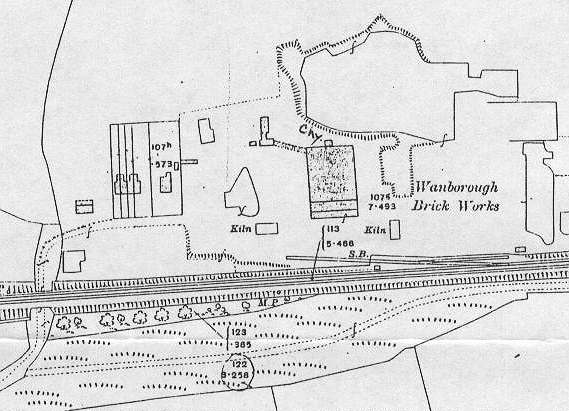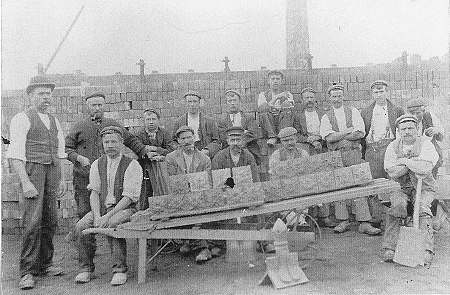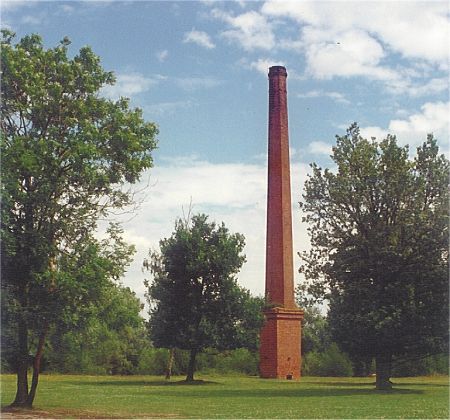| Wanborough Brickworks
Much of early brick production was carried out in small batches usually
near to where the bricks were to be used. There are several sites within
Normandy parish where names of fields indicate where the clay for the bricks
was obtained or where the bricks were made, an example being Brickfield
Copse in the south of the parish.
Wanborough Brickworks, so called probably because it was near Wanborough
Station, was actually within the parish of Normandy. It was situated a
quarter of a mile east of the station just north of the railway line.
 Wanborough Brickworks 1916
Wanborough Brickworks 1916
It was of comparatively late date as it was first established by Philip
Shuttleworth Darnell soon after he bought the land in 1897. The land previously
belonged to Cleygate Farm which was part of the Normandy Manor Estate sold
off in lots from 1895.
The clay for the bricks was dug by hand from a pit within the grounds
in the summer months and the bricks were air-dried before being fired in
the five kilns which were draughted by the tall chimney which still stands.
Four terrace cottages for the workers and a separate house for the Manager
were built on the site. The brickworks was served by a siding running off
the main railway line to the north.
In 1917 the brickworks was purchased by W T Lamb and Sons, a London
firm of brick merchants. Although it was bought as a going concern there
is some suggestion that it had suffered a decline and was possibly closed
down during the first world war due to lack of manpower.

- A group of 15 Workmen at Wanborough Brickworks, possibly
in the 1920s
Stephen Moore is seated on the right and the man sitting on the left may
be George Turner, grandfather of Ethel and Tom Turner. Note the decorative
bricks in the barrow.
 |
Two workmen at the Wanborough Brickworks c1920s |
The new owners adopted a different system of brick production. The clay
was mixed with clinker, the process of firing depending on a proportion
of combustible material in the brick, (Fletton bricks made in Bedfordshire
contain an amount of naturally occurring oil shale in their makeup), and
one of the kilns was used to pass hot air beneath clinker beds in the drying
room on which the new bricks were laid. This system enabled production
to be carried on throughout the year and was less dependent on the weather
than previously. About a million bricks were produced annually and the
firm specialised in high quality items for decorative purposes.
The brickworks closed in 1937 as it was becoming uneconomic mainly because
the only access by road was under a low and narrow railway arch which the
rail company would not alter. This limited the size of loads that could
be exported from the site. Another factor may have been the international
situation at the time leading to lack of orders.
There is a story that when the men employed at the brickworks were told
that they were being laid off they went to the Anchor public house to drown
their sorrows and whilst they were away the pump draining the water from
the clay pit stopped . The pit rapidly filled with water but this was not
the reason why the brickworks closed. It is more likely that the decision
to close was taken and then the pump was shut down.
The kilns soon became derelict but the cottages, still owned by W T
Lamb, continued to be lived in and the chimney was saved as a landmark
for the Army and as an air navigation aid. The railway sidings were removed
in the mid 1960s. The former Manager's house, known as "Ivy Cottage"
was pulled down but in 1977 the property was sold to Mr and Mrs John Fenner.
They renovated the cottages and converted them into a single dwelling with
an annexe and they cleared the ground for equestrian events.
The Fenners sold the property in 1988 to Mr and Mrs David Crook who
kindly gave Normandy Historians permission to organise two parties of visitors
to view the site of the former brickworks in 1993.

- Chimney viewed from South West"
Today, the only evidence of the works is the chimney standing in splendid
isolation and the former clay pit now filled with water and forming a picturesque
pond.
I am indebted to an account by Brian Marshall and the researches of
Pat Ashworth and Judy Turner for material to write this article.
Jack Kinder |